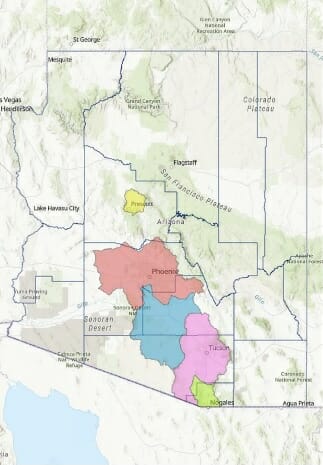Challenges facing rural water systems in Arizona and possible solutions to those problems, were the subject of a public webinar on Thursday hosted by the Arizona Department of Environmental Quality (ADEQ) Water Quality Division.
DEEPER DIVE: Here’s a look at the future of water in Arizona
READ ALSO: Some fast facts to know about the Arizona water supply
Water systems in rural towns in Arizona face challenges with resources, workforce, infrastructure, and long-term financial planning. Due to inflation and Arizona’s current drought small water systems (systems that regularly serve at least 25 individuals at least 60 days out of the year) are forced to rely on government assistance, reserves, and nonprofit organizations such as the Rural Water Association of Arizona (RWAAZ), and the Rural Community Assistance Corporation (RCAC) to stay viable. The webinar which was organized by the Water Quality Division’s Safe Drinking Water Value Stream Capacity Development Program, highlighted resources, including financial and technical assistance for small water operators, but eligibility requirements exclude Pima, Pinal and some parts of Maricopa County.

The webinar offered tips such as how to apply for grants and loans, as well as technical assistance with operations. Henry Cornejo, Water Treatment Operator with Wastewater Program Services at RWAAZ said help is available “we would like to assist and help with any sort of expansions going on.” The webinar also offered a sense of security and hope for owners. Deai Smith, a certified operator, said “this is a new era for the RWAAZ, we are looking to find solutions and new directions for the future, reaching out is the best thing to do to get your needs met.” Smith added, “We don’t want to just create solutions we want to get things up and moving.”
However, it was pointed out in the meeting that many grants and loans discussed in the webinar don’t support all owners. For example, the Water & Waste Disposal Direct Loans and Grant covers “low-income areas with health and safety issues,” and “rural areas under 50,000 in population” excluding other small water system owners who don’t meet those requirements. Another example of exclusivity when it comes to relief is the Water Supply Development Fund which excludes rural water supply owners geographically; only supplying to cities and towns “located outside AMA’s in Maricopa, Pima, and Pinal County.”
The webinar also examined supply limits. Government funds and grants for rural owners are limited. During the webinar as RCAC’s Rural Development Specialist Mario Casillas presented tips on financial planning, warning owners, “There’s no free lodge and there’s no unlimited reserve.” He also emphasized owners only use their emergency reserves for the “most expensive/critical component.” The changing economy is another reason rural owners need financial planning. According to Casillas “reserves aren’t going nearly as far due to inflation.”
The access and amount of supply rural owners receive depends on funding for the program. For example, the Water and Energy efficacity grant by the ADEQ’s small scale water efficiency project (SWEP), is eligible for rural small water system owners. This grant accounts for small scale on the ground projects such as canal lining, piping and irrigation flow measurement. However, applicants can come from 17 western states, tribes, cities, and irrigation districts. Linda Taunt, the Development Coordinator for ADEQ stated “funding is allocated through an annual competitive process.”
The resources available to small water supply owners also don’t amount to a lot of money compared to larger systems. The maximum amount of money for any one project of (SWEP) is 250,000, and according to The Cost-Effectiveness of Irrigation Canal Lining and Piping in the Western United States, it cost between $30,000 to $228,000 to install lining on one line of canal.




